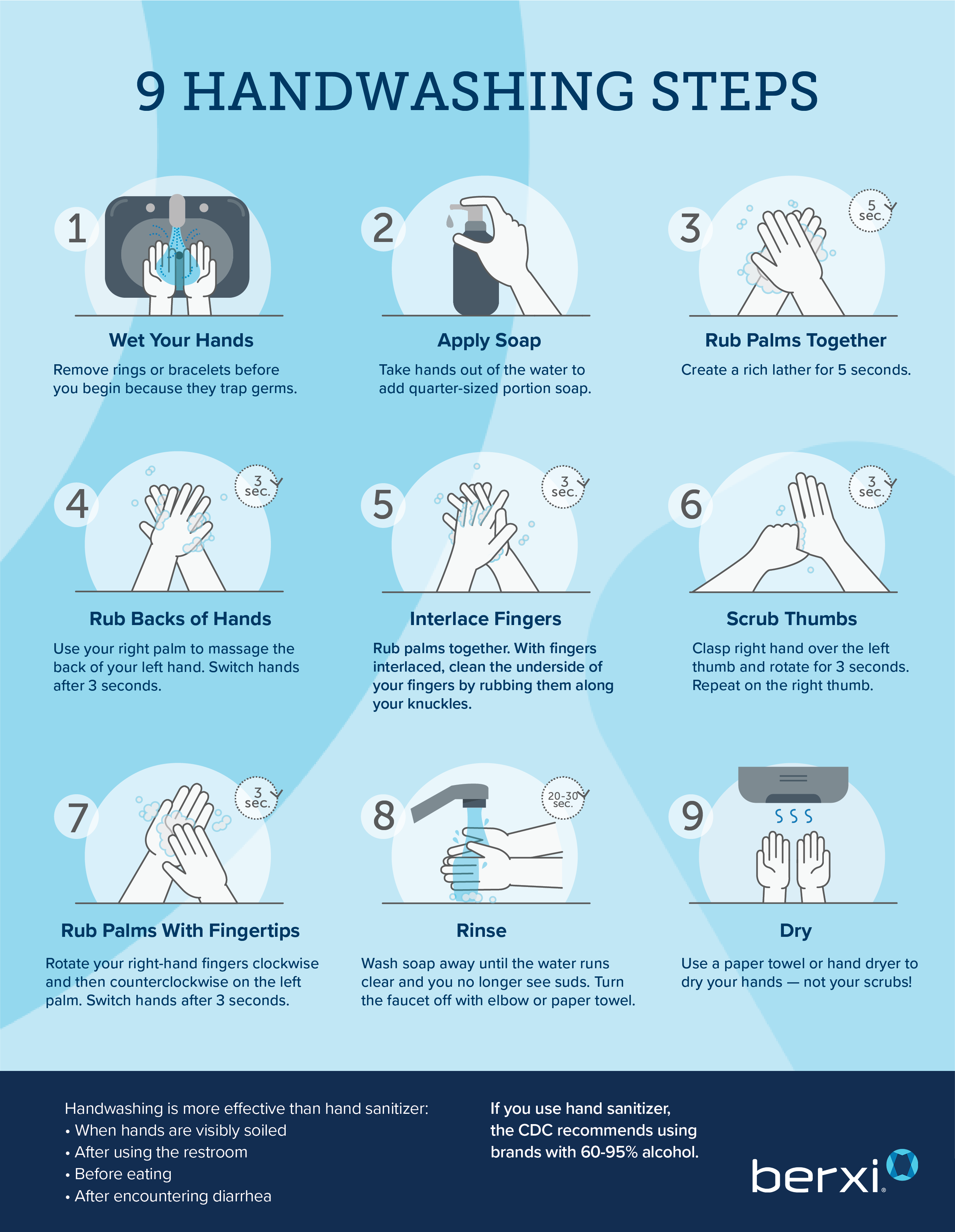
A 2020-2021 study published by the U.S. Department of Agriculture discovered that 95 percent of people don't wash their hands properly. This is a pretty shocking discovery that should give everyone pause, especially those who care for sick patients on a regular basis like nurses.
Keep in mind, though, that there are a lot of opinions out there about the “right” way to wash your hands. In fact, a surprising amount of them either gloss over or completely skip some critical sanitizing steps in the washing process. To clear this up, we decided to find out what the World Health Organization (WHO) recommends as the proper technique for handwashing.
The WHO's 9-Step Procedure for Proper Handwashing
Take a look at our infographic below to see an outline of the WHO's nine-step process for proper handwashing that they encourage everyone -- including nurses -- to follow.

And here are more detailed instructions if you'd like to learn more about each step:
Step 1: Wet your hands.
Make sure that you're using running water of at least 100 degrees Fahrenheit and that you've removed any jewelry (e.g., rings or bracelets) before you begin because they can trap germs.
Tip: If you’re worried about losing your rings, wear them on a chain around your neck when you’re at work, or keep them in a ring dish near the sink.
Step 2: Apply soap to your hands.
Remove your hands from the water and use a squirt of soap to remove soil and transient microorganisms from your skin.
Step 3: Rub your palms together.
With hands still out of the water, rub palm to palm for about five seconds to create a rich lather.
Step 4: Rub your hands over each other.
Massage the back of your left hand over your right palm for three seconds to spread the soap. Repeat the above process with your left palm on the back of your right hand.
Step 5: Interlace your fingers.
Rub your palms over one another, this time interlacing your fingers. Keeping your fingers interlaced, run the backs of your fingers along the back of the opposing hand. Do this for three seconds.
Step 6: Scrub your thumbs.
Rub your right thumb with your left hand, clasping it tightly while rotating for three seconds. Repeat the above with your left thumb.
Step 7: Rub fingertips against palms.
Using the fingers of your right hand, rub your left palm in a circling motion for three seconds, going both clockwise and counterclockwise. Repeat the above process with your left fingers and right palm.
Step 8: Rinse your hands.
Once you've been cleaning for 20 to 30 seconds, rinse the soap off your hands until the water runs clear and you don't see suds. When you're finished, use a paper towel to turn off the faucet. Because you've touched it with dirty hands, there's a good chance that it's harboring the bacteria and germs you just washed off.
Step 9: Dry your hands.
Dry your hands with paper towels or a hand dryer rather than a cloth towel, which collects bacteria. Also, be sure not to wipe your hands on your scrubs.
Washing Hands vs. Using an Alcohol-Based Hand Rub
We talked to several experts at the Centers for Disease Control and Prevention (CDC) who recommend two methods to routinely clean your hands: handwashing with soap and water or hand antisepsis using an alcohol-based hand rub. Hand antisepsis is preferred in most clinical situations; however, there are times when washing your hands is a much better option.
When Should Nurses Wash Their Hands?
According to the CDC experts, you should always wash your hands:
- When hands are visibly soiled
- After using the restroom
- Before eating
- After caring for a patient with an acute diarrheal illness
- After touching surfaces or equipment used in the care of a patient with an acute diarrheal illness
When Should Nurses Use Alcohol-Based Sanitizers?
However, you should opt for using an alcohol-based hand sanitizers:
- When hands are not visibly soiled
- Before having contact with a patient
- Before putting on gloves
- Before putting on gloves to insert a sterile device (e.g., urinary or intravenous catheters)
- During care when moving from a contaminated body site to a clean body site
- After contact with the patient
- After contact with surfaces or equipment in the patient environment
- After removing gloves
To learn more about the differences between the two approaches, check out our article “Hand Sanitizer vs. Washing Your Hands: Which Is Better?”
How to Keep Clean Hands From Drying Out
With so much handwashing going on, you might see your hands get dry and cracked more often. The following are a few ways to keep them soft and conditioned.
- Moisturize your hands with lotion or balm (but if you’re at work, only with those products provided by your facility—NEVER use products from home).
- Use paper towels instead of hot air dryers.
- Exfoliate your hands with a sugar and oil olive scrub one to four times a week.
- Apply pure aloe every night.
- Use a humidifier at home.
Header image courtesy of iStock.com/georgeclerk
Video courtesy of Johns Hopkins Medicine.
